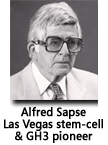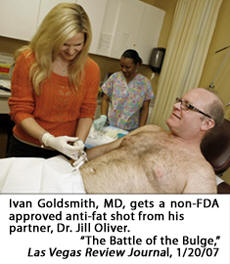 The
rise of Nevada as a "Healing Mecca" did not happen
overnight. Instead, the state's peculiar legal
climate developed over decades as state officials
allowed homeopaths, ordinary physicians, and unlicensed MD's such as
Alfred T. Sapse
to expand their capacity to profit from
offering irrational remedies to vulnerable patients.
During the 1970's, Sapse, who is now under fire for
illegal stem-cell research, persuaded Nevada
lawmakers to ignore FDA warnings and legalize
Gerovital,
an anti-aging drug that has been banned in every other state.
The same bill legalized laetrile as a cancer treatment
even though it has never been shown to be effective, has
been associated with cyanide poisoning, and has
been characterized by
mainstream medical scientists as akin to suicide for
those who are seriously ill. In 1998, with the
same indifference toward medical evidence, the Nevada State Board of Medical Examiners
approved the use of
chelation therapy
as an alternative
to established approaches to treating heart disease even
though this unproven treatment had been rejected by the
FDA, the
American Heart Association,
the Centers for Disease Control and many other medical
agencies and associations.
The
rise of Nevada as a "Healing Mecca" did not happen
overnight. Instead, the state's peculiar legal
climate developed over decades as state officials
allowed homeopaths, ordinary physicians, and unlicensed MD's such as
Alfred T. Sapse
to expand their capacity to profit from
offering irrational remedies to vulnerable patients.
During the 1970's, Sapse, who is now under fire for
illegal stem-cell research, persuaded Nevada
lawmakers to ignore FDA warnings and legalize
Gerovital,
an anti-aging drug that has been banned in every other state.
The same bill legalized laetrile as a cancer treatment
even though it has never been shown to be effective, has
been associated with cyanide poisoning, and has
been characterized by
mainstream medical scientists as akin to suicide for
those who are seriously ill. In 1998, with the
same indifference toward medical evidence, the Nevada State Board of Medical Examiners
approved the use of
chelation therapy
as an alternative
to established approaches to treating heart disease even
though this unproven treatment had been rejected by the
FDA, the
American Heart Association,
the Centers for Disease Control and many other medical
agencies and associations.

That same
year,
Dr. Alan Mintz, who received
national attention for
his crusade against aging, took advantage
of Nevada's
loose approach to healthcare to found the
Cenegenics Medical Institute
in Las Vegas. A radiologist, Mintz
never bothered to obtain a medical license in Nevada and
seems to have spent most of his time headlining
anti-aging conferences, using his own physique to
advertise the benefits of steroid and hormone injections
to fight the "disease" of old age. Mintz was
scheduled to tout the effectiveness of his
highly
dubious treatments, which cost upwards of $10,000 per
year, at the annual Age Management Medicine Conference
in Las Vegas in November 2007. However, he seems
to have discovered the ultimate cure for aging,
having died at the age of 69 as a result of a
hemorrhage during a brain biopsy in June.
The
longevity doctor's untimely death was memorialized
at the conference with the presentation of the
Alan P. Mintz Award for Clinical Excellence in Age
Management Medicine and, as the epicenter of the
anti-aging industry, Nevada offered a long list of
potential recipients. The Mintz prize might have
gone to
Las Vegas physician
Adelaida Resuello, MD, who was recently given a
paltry fine of $2000 by the Nevada State
Board of Medical Examiners for injecting and assisting
an unlicensed person to inject fake Botox into
unsuspecting patients. Another plausible prospect
was Stephen Seldon, MD, a Las Vegas doctor who also
specialized in substituting an unapproved botulism toxin
for the more expensive Botox. Seldon's record with
the Nevada Medical Board is clean, but
he and his wife,
Deborah Martinez Seldon, were
arrested last June after a
federal grand jury indicted them for mail fraud and
other charges related to their fake Botox scheme.
 In view of the Seldons' well-publicized legal problems,
the Mintz award could have been picked up by
Ivan Goldsmith, MD, an anti-aging specialist who
serves as medical director of a
NeoStem facility which
hosted its first procedure
during a ceremony at the Trimcare Medical Center in
Henderson in November 2007. NeoStem, a
financially troubled but fast-growing company, uses
highly invasive methods to collect stem cells
from adults in the
unlikely event
that these cells could
prove handy if scientists invent safe and effective
adult stem-cell therapies in the relatively near term.
Goldsmith underscored the speculative aspect of
NeoStem's pitch to consumers,
declaring
in a press release,
"I believe that both local
residents, as well as tourists from around the world,
will be inclined to bank their stem cells for their
future personal use with the same enthusiasm as they
would demonstrate at the gaming tables in a casino."
In view of the Seldons' well-publicized legal problems,
the Mintz award could have been picked up by
Ivan Goldsmith, MD, an anti-aging specialist who
serves as medical director of a
NeoStem facility which
hosted its first procedure
during a ceremony at the Trimcare Medical Center in
Henderson in November 2007. NeoStem, a
financially troubled but fast-growing company, uses
highly invasive methods to collect stem cells
from adults in the
unlikely event
that these cells could
prove handy if scientists invent safe and effective
adult stem-cell therapies in the relatively near term.
Goldsmith underscored the speculative aspect of
NeoStem's pitch to consumers,
declaring
in a press release,
"I believe that both local
residents, as well as tourists from around the world,
will be inclined to bank their stem cells for their
future personal use with the same enthusiasm as they
would demonstrate at the gaming tables in a casino."
All of
these doctors have done much to sustain Mintz's campaign
against old age, but that's not all they have in common.
According to the
Las Vegas Sun,
Resuello, Seldon, and
Goldsmith, along with Joel Lubritz, MD, a plastic
surgeon and
former member of the Nevada State Board of Medical
Examiners, were all named as defendants in a civil
complaint filed in
March 2005 by the U.S. Attorney's Office. The
complaint alleged
that they had participated in a scheme involving fraudulent insurance claims and
kickbacks paid to employees of
SDI Future Health, Inc., a
California-based diagnostic testing services company
that operated medical clinics in Nevada.

As it turned out, the conference leaders did not look far
for their winner: the Mintz Prize went to Dr. Jeffrey S.
Life, one of Mintz's partners at Cenegenics, who also shows
off his own physique to advertise the benefits of human
growth hormone and other questionable antidotes to old age.
To understand why so many
medical profiteers have prospered in Nevada,
it is essential to look at the long
history of
incompetence at the State Board of Medical
Examiners, a record that is especially evident in the
supposedly hostile, but, upon closer examination,
surprisingly cozy relationship that it has carried on
with the Nevada State Board of Homeopathic Medical
Examiners, which was established in 1983.






